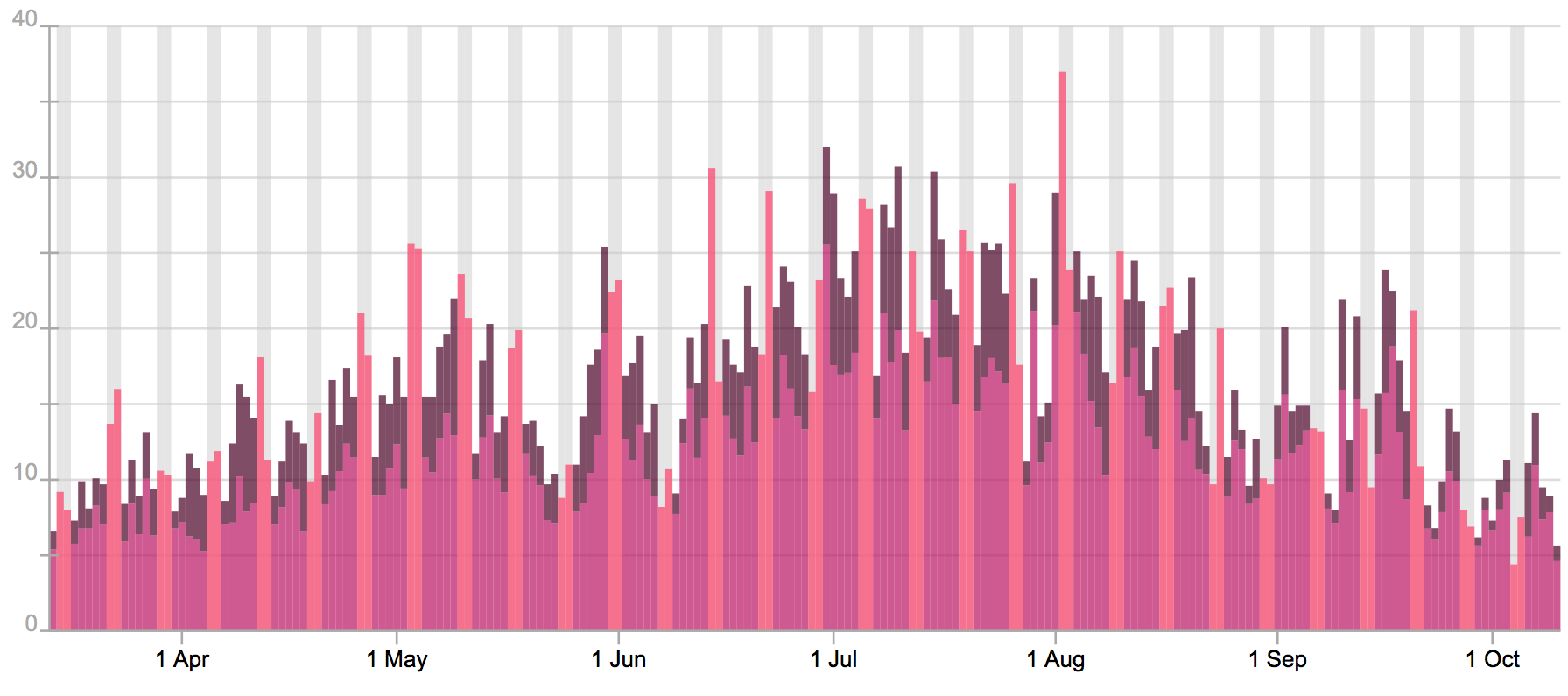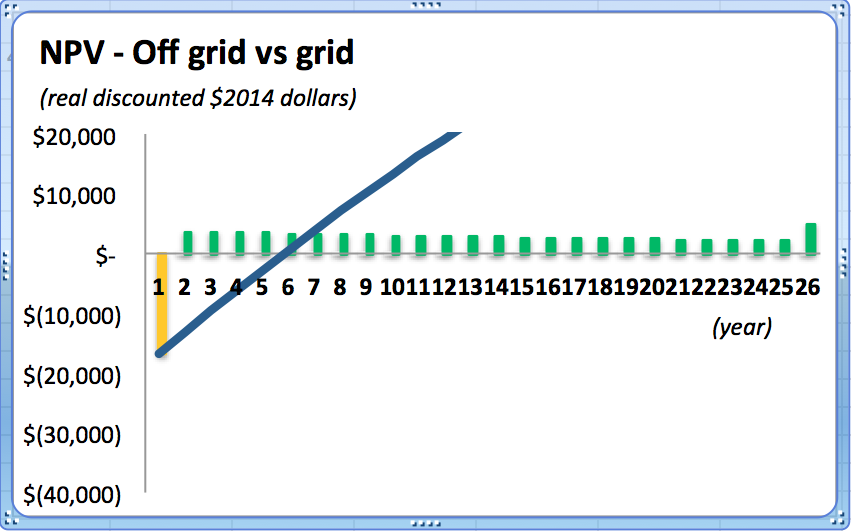Solar wins! Zombie-grid a dead man walking
The grid financial model will collapse within 10 years, as millions of Australian households flee for the new, disruptive and cheaper alternative. This change will be as big as the conversion from horse and cart to motor vehicle, film to digital camera and the typewriter to the laptop.
The change in how we source electricity won't at all be what the cellphone has become to telecommunications; it will be far more radical. While telephony has maintained some phone lines, with the switch to broadband being a lifeline to the humble land-line, there will be no such lifeline for the grid; operators will collapse and suffer a forced restructure under the current financial and operational model.
The urban solar off-grid household
Modeling by Zero Emissions Australia shows that an ordinary, but all-electric, household using off-the-shelf efficient electric appliances could be off the grid for between $30,000-$40000 today and $12,000-$20,000 in 2024.
This is based on the following representative example of electricity demand charted below for an all-electric five-person household in Melbourne.
Example: One year of average monthly demand for all electric household in Melbourne (5 occupants).
Source: Powershop, Zero Emissions Australia
Example 2: Winter peak period daily demand for all electric household in Melbourne (5 occupants).

Source: Powershop, Zero Emissions Australia
Households can install and size their off-grid solar system now and change their redundant gas appliances (stove top, gas hot water and gas heating) over later. Or, given that the price is going to be right to leave sometime in the next 10 years, they can start their electric conversion journey now. Ditching gas and the power grid starts by installing an oversized solar system (11-15kW) on the north, east, west and possibly even flat-racked. Indeed you can place it on the south face which captures diffuse light when its cloudy – which contributes over half of all generation during the middle of winter (more on that in another article).
The next order of business, to ready for the switch, is to upgrade three major appliances so you can go fully solar. Do the following and you will fly past those “cooking with gas” as you sizzle with solar.
1) Induction cooktop to replace their outdated gas cooktop. Let's be clear; induction cooktops are more effective, safer and more efficient. Cost $800
2) Sanden CO2 heat pump hot water unit. It ‘s quiet, achieves Coefficient of Performance (COP) of ~4.0 or (400% efficient, yes that is possible) on an annual basis and 3.0 in the worst of winter which is what counts. Cost $3000
3) Two Daikin Ururu Sarara COP 6.0 humidity heaters (aka, reverse cycle air conditioners) for main living areas. They use 83% less energy than an electric heater and 86%-92% less energy than a gas heater (depending on the age and type installed). Cost $4000
And two to four – depending on the size of the house – regular $1000 efficient Daikin, Mitsubishi, Panasonic, etc, COP 5.0 reverse cycle air conditioners for the rest of the house. Cost $2000-$4000
Total: All electric house conversion $9800-$11800
And in return the household will obtain:
– Significant energy savings.
– Significant bill savings.
– High performance, premium appliances, an upgrade on what households had previously.
Go solar: How much, what size?
Zero Emissions Australia will be releasing a sizing calculator on our website shortly, which a homeowner can use to import their demand data from their smart meter (if they are lucky enough to live in Victoria and have a smart meter installed that is). But until that time, we've got a fairly representative example case study to guide you.
We've modeled a number of, all-electric, efficient houses – with occupancies ranging from one to six persons – to come up with a system that will provide equivalent reliability to the grid. This system shows reliable and secure operation for these houses through the worst of winter (based on up to three years of smart meter data). Given winter is the toughest test due to high heating demand and low solar radiation, the rest of the year is a walk in the park.
Figure 3: June 11-14, 2013, the lowest solar period of the last four years.

Source: pvoutput.org, Team Melbourne, 83 solar systems monitored.
In order to predict and size an appropriate system for our given case studies, we were able to use the publically available data from real PV systems at pvoutput.org. In the case of Melbourne the real production data stretches back four years. A simple survey that we conducted showed that most people would be happy to leave the grid if they knew that a replacement stand-alone solar system would have given them 100% security of supply over the past four years.
For our modeling, we took actual load data from our all-electric households and moved that load data back and forth testing all the different load cycles against the solar data. So in effect, we lined up the worst load with the worst solar production to give a worst-case scenario for our design. A scenario that never actually occurred in real life so, in effect, we've been very conservative.
The results
An average household in the suburbs will require up to 15kW of panels to get off the grid. They'll most likely be installed as:
– 9kW facing north requiring 44m2 of roof space in 2014 dropping to 22m2 by 2024.
– 3kW facing west (requiring 15m2 of roof space in 2014 dropping to 7.5m2 by 2024) and another 3kW facing east.
To work out the space required we've used the second best panel on the market, the Sunpower/BENQ 327W, given that other major manufacturers will catch up to this level of efficiency with their cheaper offerings in the next one to three years.
The analysis finds that disconnecting from the grid is already profitable at these prices.
This is based on a discount rate of 5%, which reflects the cost of finance for most homeowners via homeloan redraw or refinancing opportunities.
The 2014 NPV for our example case, using a system lifetime of 25 years is $20,529 with a real payback of less than 15 years, with the cashflow of the investment illustrated below:
The NPV for our example case in 10 years time (2024), using a system lifetime of 25 years is $55,684 with a real payback of less than five years:

Today's panel cost is based on the unsubsidised cost of a True Value Solar supplied system (the largest Australian solar retailer) at $1.60 per watt fully installed. In addition we've found this will be readily price matched by the second-largest solar retailer, Solargain.
The pricing of the system's batteries are based on Tesla's current rate for purchasing batteries it sources for its electric vehicles of $225 per kWh. Tesla achieves this price based on a volume of approximately 1200 cars per month. Therefore approximately 1200-1500 houses would have to be installed per month to achieve a similar all-in system pricing. This isn't a big ask given that, at its peak, the solar industry in Australia was installing 60,000 systems a month.
The price in 2024 is based on a flatlining of the projected 2017 panel cost of $0.30/W and assuming a doubling of efficiency via the development of thin-film/perovskites on silicon technology (Martin Green, UNSW, 2014). Other cost reductions occur due to only having to install half as many panels to achieve the same capacity as today (i.e. twice as efficient panel with twice the rating needs the same labour input to mount on the roof and wire up).
A full breakdown of the capital costs at current and projected 2024 prices is provided in tables at the bottom of this article.
Conclusion
So as you can see, for the early movers the time has come to get off the grid today.
For the rest of us it's time to buy our 15kW solar system, while the Small-scale RET solar rebate is still available, and shift our houses off gas to all-electric (and efficient) appliances.
For those savvy enough to see the writing on the wall, the big opportunity is for someone like a SunEdison (who has just entered the Australian market) a Powershop or a Pacific Hydro to make a business out of long-term contracts for financing these solar migrations. Until then cash-on-hand and home loan redraws will kick start this revolution.
In our next column we'll talk about an action plan for households to ready themselves to start their grid independence journey. This will be followed by what the grid operators can do to work with solar, rather than against it, and the rise of the virtual utility.
Matthew Wright is executive director of Zero Emissions Australia, director technical sales at Efficiency Matrix and resident columnist at Climate Spectator.
Figure 6: 2014 - Capital cost for large all-electric, stand-alone solar household
Source: Zero Emissions Australia
Figure 7: 2024 - Capital cost for large all-electric stand-alone solar household

Source: Zero Emissions Australia
















